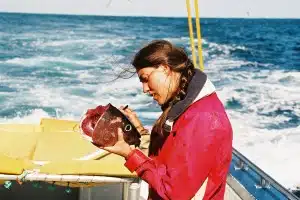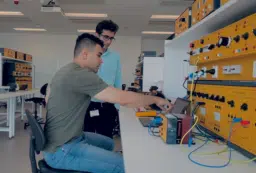
Sophie Bestley catching tuna, photo credit Thor Carter, CSIRO
Issued on World Oceans Day
Southern bluefin tuna can’t even have a quiet snack without CSIRO researchers knowing. They’ve developed a way of tracking when the tuna feed and also where, at what depth, and the temperature of the surrounding water.
It’s the first time anyone has been able to observe the long term feeding habits of migratory fishes directly and the information is transforming our understanding of these highly sought after ‘Porsches of the sea’.
Dr Sophie Bestley and her colleagues at CSIRO’s Wealth from Oceans National Research Flagship surgically implant miniaturised electronic “data-storage” tags into juvenile fishes off the coast of southern Australia.
Already the team has found that tuna feed almost anywhere they can three days out of four-even during their massive annual migrations-but that some hunting grounds are more lucrative than others.
The information will assist future management of what is currently an overfished and depleted species which supports a global commercial fishery worth more than US$1 billion a year.
“Direct and long-term information on feeding is extremely rare for migratory marine species,” says Sophie, “and is available for bluefin tunas only as a result of their unique physiology and long-term electronic tagging programs instituted by CSIRO.” When the tunas feed, the metabolic energy produced during digestion causes their tummies and surrounding tissues to heat up. This warming is recorded by internal temperature sensors on the tags.
Southern bluefin tuna are supreme hunters. They feed on average on 76% of all days, throughout the temperate ocean in waters ranging from 5 to 23°C, and can catch a meal at the surface or as deep as 672 m.
A surprising finding was that the sensors also recorded “cold tummies”, or fasting periods, of up to 24 days. These occurred mostly in waters warmer than 15°C, suggesting these areas may be important for reasons other than feeding, perhaps resting or navigation.
“Sophisticated tagging technologies have revolutionised our ability to study long-ranging and deep-diving marine animals previously impossible to observe,” says John Gunn, one of Sophie’s PhD supervisors. “They form part of a greater global effort toward understanding what drives highly migratory species.”
The animals in this study swam from the Great Australian Bight to winter in the south Indian Ocean, between 4000 and 8000 km away, before returning often close to where they were originally tagged the previous summer.
Tags are returned by fishermen-mostly Australian, Japanese or Taiwanese-and attract a reward of A$250, plus a t-shirt, cap or mug as a thank-you for cooperating with the tagging effort.

Sophie Bestley removing the otoliths (ear bones) to age the fish, photo credit Thor Carter, CSIRO
Why is migration and feeding behaviour important? “Well, as these amazing fish spend their life moving across three oceans, while being fished by international fleets with different types of fishing gear, assessing how many there are and what level of catch is sustainable in the long term is a very complex task,” says Sophie. “My work will help us build a better understanding of i) where they are at what time of year and ii) whether they likely to be harder, or easier, to catch in different places and times. This information can then be used in models to provide advice on the status of the stock and what levels of catch are sustainable and will allow the stock to rebuild.”
Sophie Bestley is one of 15 early-career scientists presenting their research to the public for the first time thanks to Fresh Science, a national program sponsored by the Federal Government. This work forms part of her PhD studies under the Joint University of Tasmania-CSIRO PhD Program in Quantitative Marine Science.
Tracking tuna over a year, credit Sophie Bestley/CSIRO





 Fresh Science is on hold for 2022. We will be back in 2023.
Fresh Science is on hold for 2022. We will be back in 2023.